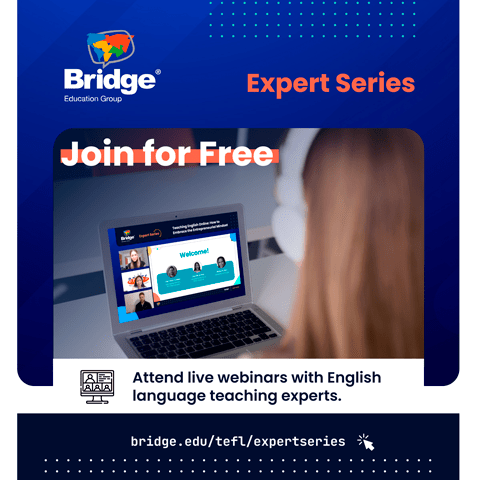With the accelerated growth in technologies of the last 5-10 years, teachers have gained access to an incredible arsenal of tools that can greatly enhance learning. While teachers of all age groups may be integrating multimedia content into instruction, it’s particularly crucial for Business English teachers, as their students are working professionals learning English to apply it in their professional capacity. Let’s take a deeper look into why multimedia should be used in Business English lessons, some examples of multimedia tools, and ways to incorporate multimedia into your Business English classroom.
Looking for training to launch a career teaching Business English? Get targeted training with Bridge’s 60-hour Teaching Business English Specialized Certification course.
- What are the benefits of using multimedia in Business English lessons?
- What are some multimedia tools you can use to teach Business English?
- What are strategies for developing content that targets business communication skills?
- What are some examples of multimedia projects students can create and present?
What are the benefits of using multimedia in Business English lessons?
Whether they are used to engage students or better convey lesson content, there are many tools available today to help you integrate multimedia. Integrating audio, video, imagery, and interactive elements into lessons can increase understanding, concept retention, and student engagement.
Multimedia comes in many different forms and can be used for a variety of purposes. For example, animated presentations may be used to liven up storytelling, while social media videos like reels make it easier to connect with other users.
Multimedia is especially useful in the Business English classroom, as students are learning English as a 21st-century career skill to apply in a professional capacity. Students engage in language training to communicate in a variety of ways that make use of multimedia tools, such as emails and presentations. Additionally, many Business English students will be interacting with other non-native speakers, and multimedia use provides ways to teach English as a global language, exposing students to diverse accents, dialects, and cultural contexts.
When developing Business English lesson plans, many teachers make use of mixed media to present topics dynamically or work on collaborative and hands-on projects with their adult students. If you haven’t fully embraced multimedia in your Business English classes yet, here are some reasons you should start.
Learn about how to get a job teaching Business English.

Supporting multiple learning styles
Are your students visual learners? Or are they interpersonal learners who prefer to work with their peers? Perhaps they are kinetic learners who need hands-on, authentic applications. By using multimedia in your class activities, you can tailor materials to meet diverse learning styles and facilitate comprehension and recall of the subject. For example, you can use infographics to teach visual learners, while those who love interaction can work on podcast or video creation projects.
Learn how to hyper-personalize your Business English teaching with AI.
Boosting student engagement and comprehension
It’s no secret that interactive content can spark a learner’s interest and motivate them to participate, and it will certainly work in your Business English classes too! Hands-on multimedia projects, for instance, make learner experiences more dynamic and interactive, keeping students more interested and encouraged to participate in class.
For example, integrating technology-enhanced learning through interactive ESL games is a great way to not only up the energy and engagement in class but also teach important skills like conversation, writing, pronunciation, grammar, and listening comprehension.
Additionally, students can easily connect the verbal and visual representation of content and learning outcomes, which in turn allows them to have a deeper understanding and connection with what they’ve learned.
Explore over 30 TEFL discussion questions for adults to get your students talking.
Promoting real-life application
Nine times out of ten, professionals may be required to have some sort of multimedia knowledge and skills for their job. Some may need to create presentations, for example, while others may be asked to create video content for a company’s website. With this in mind, working with multimedia with your students helps them build a skill set they can transfer to their professional tasks.
For instance, multimedia-enhanced activities like responding to emails, making presentations, and crafting written or verbal responses to authentic industry news stories can help build the real-life skill set your students will need to be successful in their careers.
Developing other soft skills
Aside from the ability to use multimedia, students can develop soft skills useful for their personal and professional growth, such as higher-order thinking, problem-solving skills, and creativity. For example, collaborating on podcast projects with their classmates can help enhance their communication skills, while crafting animated presentations can level up their creativity.
Looking for ways to integrate soft-skills instruction into your lessons? Explore Bridge’s suite of Micro-credentials in 21st-Century Teaching Skills.
What are some multimedia tools you can use to teach Business English?
From video content creators to screen recorders to animation software, there is a myriad of apps, platforms, and software you can add to your multimedia toolkit to teach Business English and recommend to your students. The other good news is that these tools generally have user-friendly interfaces and offer free versions!
Tools for creating video content
You can easily edit and enhance videos today. Video-making software has tools to add animations, special effects, and even voiceover! Many of them also come with templates you can personalize by changing the text images as well as customizable characters. Here are some platforms you can use to create personalized, engaging videos:
-
Powtoon
-
Animoto
-
Animaker
Audio editors
When it comes to creating audio-related content such as podcasts, recording memos, or doing voiceovers, audio editing and recording apps can be found in abundance. Using these apps, you can record your voice, edit the audio, and publish your work. Many audio editing software programs also let you generate a transcript, which is useful for adding subtitles or turning your podcast into an article, both of which are excellent teaching and learning resources. Some of the platforms you can use include:
-
Audacity
-
Descript
Graphic design tools
You can use online graphic design platforms to make infographics, posters, and other documents more engaging by adding images, creative designs, and other graphic elements. The following, for example, are great tools to start with, especially because they offer a wide variety of templates and designs that you can easily customize:
-
Canva
-
Adobe Express
-
Piktochart
Screen recorders
If you’re looking to create tutorials, share instructions more clearly, or give feedback on an online project, you can easily record and share the activity on your computer screen by using screen recorders. Aside from recording what’s displayed on your desktop, screen recorders also let you edit and add annotations to your video recordings. Some screen recorder apps you may find practical are:
-
ScreenRec
-
Media.io
-
ScreenPal
Story creators
Finally, you can find other types of innovative content-creation tools that make use of mixed media. Book Creator, for example, allows you to make digital books using photos, graphics, audio, links, and many other interactive elements. Meanwhile, comic creators like Pixton and StoryboardThat are great for building comic strips or digital stories to make storytelling more visual. Using these apps, you can create and personalize your comic characters, write dialogues, and even add fun icons or backgrounds.
Read about how to fast-track learning with the GSE in Business English teaching.

What are strategies for developing content that targets business communication skills?
Although it may seem challenging to select and craft content that will help your Business English students brush up on their communication skills, there are strategies you can use to make sure that your class materials and content are aligned with your students’ needs.
Choose authentic materials for real-life application
While there’s a plethora of videos, podcasts, and other types of content you can choose from nowadays, it’s crucial to narrow them down to the ones that provide real-life examples and expose your students to business language as it is used in the real world. Make sure that the dialogues in videos or audio you will use in class, for example, include functional language and Business English phrases that your students can also use when they use English at the workplace.
Teach English as a global language
As it’s not uncommon for many Business English learners these days to be connected with people around the world, choosing course content that familiarizes students with different cultures better prepares them for how they’ll use English in a professional capacity. This may mean choosing materials where speakers have varying accents or dialects or introducing topics that will help them understand different cultural contexts, such as business etiquette and cultural behaviors. By teaching English as a global language, you can better prepare your students for when they have to interact with non-native English speakers in the business world or work with multicultural teams.
Choose multifaceted materials
Variety is another key to choosing the most suitable Business English materials and content, and this could be based on:
-
The communication skills students can learn or build. When planning the next materials or topics you’ll bring to class, make sure they touch on diverse types of interactions or situations that students relate to, such as problem-solving, networking, decision-making, and negotiating. This way, learners can practice varying skills most commonly required in the business world.
-
The types of tasks you can incorporate. Your class content should also allow you to develop a variety of exercises or activities that will help students practice different English skills. When using videos, for example, you can incorporate speaking activities like debates or brainstorming sessions, in addition to listening comprehension tasks.
Raise your level of professionalism with
Specialized Certification in Teaching Business English
Get CertifiedWhat are some examples of multimedia projects students can create and present?
From crafting posters to building interactive portfolios, there are plenty of ways to get your students involved in hands-on projects that make use of multimedia. The following multimedia project ideas may help you get started.
Infographics
A simple activity that will nevertheless get your Business English students’ creative juices flowing is creating infographics. You can have them create an infographic comparing two ideas or the pros and cons of a specific topic, for example, or present a timeline of a work or business project they’ve worked on.
Podcasts
Creating podcasts is a great way to boost your learners’ speaking confidence while having fun in the process. You can choose trending issues, news, or topics related to your students’ interests for them to talk about (if your students are too shy, you can also facilitate or host the conversation). After recording the conversation, you or your students can edit the audio by adding sound effects or music before sharing it with the rest of the class.
Mini presentations
Business English students can also put their multimedia skills to work by crafting creative short presentations. You can come up with a work or business-related topic and challenge your students to present it in the most creative way possible (make sure to suggest apps or other digital tools they can use). You can even turn it into a competition by having a “Best Presentation” award for the most creative presentations!
Explore six ways to use AI as your personal teaching assistant.
Tutorials
Another way for your students to take advantage of multimedia tools is by working on tutorial projects, which is great for practicing transition words, phrases for giving instructions, or imperative verbs. For this, you can have them collaborate on making an instructional video or a step-by-step guide to do something on their computer. For example, they can record their screen to show how to send an email or create a social media post.
Digital portfolios
Finally, your students can put a digital portfolio together, which could be their ongoing project throughout the course or their final task for their Business English course. You can also propose different ideas, from their company projects to work achievements, to the entrepreneurs they admire. As long as the topic inspires them, there’s no doubt that your students will be enthusiastic when building their portfolios!
-
Pro Tip: When choosing a multimedia project for students to work on, don’t forget to consider your students’ limitations, too. Some learners may not be tech-savvy enough to operate innovative platforms, and some may not have access to certain applications.
By using multimedia and choosing the right content for your Business English lessons, you can bring your materials to a more interactive level while helping your learners have a better grasp of the language and be equipped with the essential skills they need for their professional growth.











